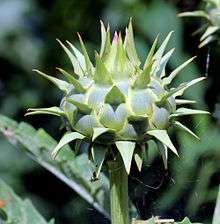Cynara
Cynara is a genus of thistle-like perennial plants in the sunflower family. They are native to the Mediterranean region, the Middle East, northwestern Africa, and the Canary Islands. The genus name comes from the Greek kynara, which means "artichoke".[2]
| Cynara | |
|---|---|
 | |
| Cynara cardunculus | |
| Scientific classification | |
| Kingdom: | Plantae |
| Clade: | Tracheophytes |
| Clade: | Angiosperms |
| Clade: | Eudicots |
| Clade: | Asterids |
| Order: | Asterales |
| Family: | Asteraceae |
| Subfamily: | Carduoideae |
| Tribe: | Cynareae |
| Genus: | Cynara L. |
| Synonyms[1] | |
| |
Among the better known species in this genus include:
- Cynara cardunculus is the cardoon, artichoke thistle, or wild artichoke. The stems of cultivated varieties are used as food around the Mediterranean. It is a common source of a coagulant used as an alternative to rennet in the manufacture of cheese, with the advantage that the cheese is then fully suitable for vegetarians; many southern European cheeses are traditionally made in this way. The more commonly eaten globe artichoke is usually considered to be an ancient cultigen of this plant. Cardoon is an invasive species in United States, Argentina, and Australia.
- Cynara humilis is a wild thistle of southern Europe and north Africa which can be used in cheesemaking like C. cardunculus.[3]
- Cynara scolymus (syn. C. cardunculus var. scolymus) is the common edible globe artichoke. It differs from C. cardunculus in that the leaf lobes and inner bracts of involucre are less spiny.
- Cynara cornigera leaves and flowers are eaten raw or cooked in Crete.[4]
Cynara species are used as food plants by the larvae of many lepidopterans, such as the artichoke plume moth (Platyptilia carduidactyla), a pest of artichoke crops.[5]
C. cardunculus is being developed as a new bioenergy crop in the Mediterranean because of its high biomass and seed oil yields even under harsh conditions.[6][7]
Species
The genus consists of the following species:[1][8]
- Cynara algarbiensis - Spain, Portugal
- Cynara auranitica - Iraq, Syria, Lebanon, Israel, Palestine, Jordan, Turkey
- Cynara baetica - Spain, Morocco
- Cynara cardunculus - cardoon - from Ireland + Canary Islands to Azerbaijan; naturalized in other regions
- Cynara cornigera - Greece, Libya, Cyprus, Egypt, Libya
- Cynara cyrenaica - Crete, Libya, Cyprus
- Cynara humilis - Spain, Portugal, Algeria, Morocco, Canary Islands
- Cynara makrisii[9]
- Cynara scolymus (syn. C. cardunculus var. scolymus) - artichoke - area of origins unclear but probably Mediterranean; widely cultivated and naturalized
- Cynara syriaca - Cyprus, Iran, Lebanon, Syria
- Cynara tournefortii - Morocco, Spain, Portugal
gollark: !time <@319753218592866315>
gollark: Obviously I should just do @everyone, which is one of my few powers.
gollark: Is that all this is to you, Lyric? A game?
gollark: What, the !lyricly!demote! thing? There've been more.
gollark: Does Desktop Goose not have linux support?
References
- Flann, C (ed) 2009+ Global Compositae Checklist
- Cynara. Flora of North America.
- Vioque, M., et al. (2000). Chemical and microbiological characteristics of ewes' milk cheese manufactured with extracts from flowers of Cynara cardunculus and Cynara humilis as coagulants. Journal of Agricultural and Food Chemistry 48(2), 451-56.
- Kyriazopoulos, A. P., et al. Edible plant species in rangeland ecosystems of Crete, Greece. In: Grassland farming and land management systems in mountainous regions. Proceedings of the 16th Symposium of the European Grassland Federation, Gumpenstein, Austria, 29–31 August 2011. pp. 505-07.
- Artichoke Plume Moth, Platyptilia carduidactyla. Integrated Pest Management. University of California. Updated 2009.
- Fernández, J., et al. (2006). Industrial applications of Cynara cardunculus L. for energy and other uses. Industrial Crops and Products 24, 222–29.
- The seed characteristics, seed composition, and allometric relationships predicting seed yields in the biomass crop Cynara cardunculus. Global Change Biology Bioenergy. 2-3, 113-129.
- Cynara. The Plant List.
- Hand, R. and G. Hadjikyriakou. (2009). Cynara makrisii (Asteraceae, Cardueae), a new artichoke species in Cyprus. Willdenowia 39(1) 77-81.
External links
| Wikimedia Commons has media related to Cynara. |
| Wikispecies has information related to Cynara |
- GRIN Species Records of Cynara. Germplasm Resources Information Network (GRIN).
This article is issued from Wikipedia. The text is licensed under Creative Commons - Attribution - Sharealike. Additional terms may apply for the media files.